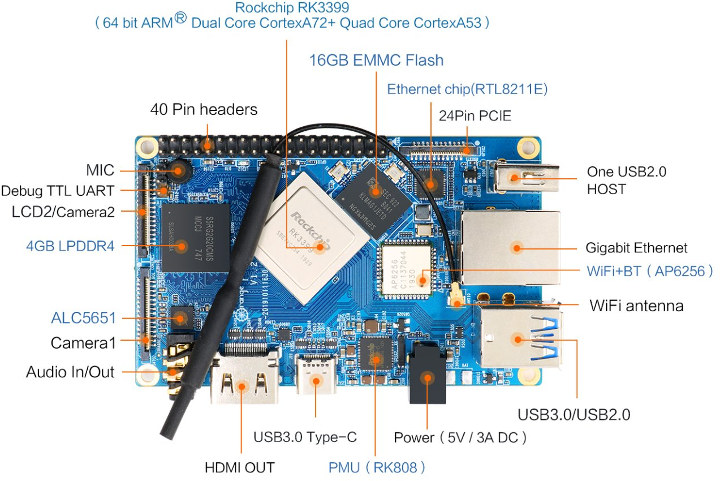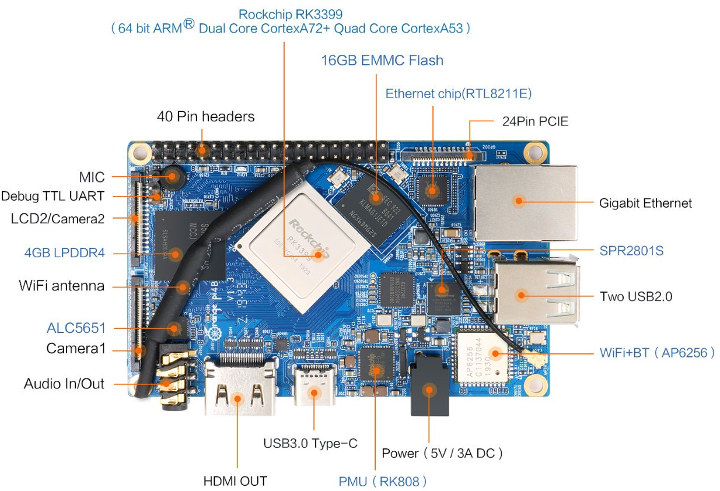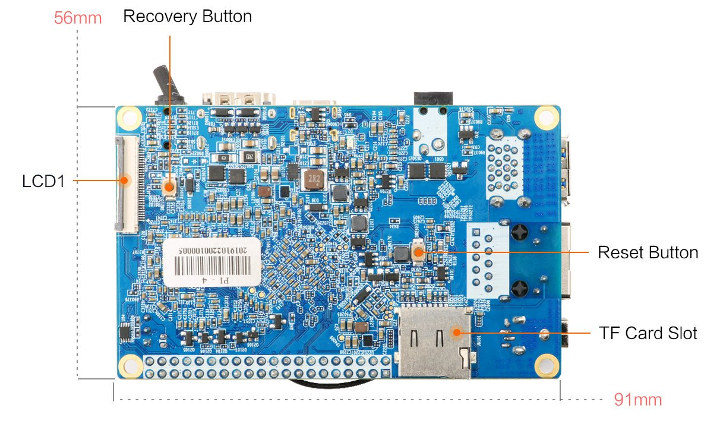Shenzhen Xunlong Software’s Orange Pi RK3399 single board computer launched in early 2018 with 2GB RAM for $109, and earlier this year, the company launched an updated version with 4GB RAM and a lower $99.96 price tag.
But there are plenty Rockchip RK3399 SBC’s on the market, including FrienglyELEC NanoPi M4 going for $50 and up ($75 with 4GB RAM), and Pine64 RockPro64 board starting at $59.99 with 2GB RAM, and $79.99 with 4GB. So unless you need the extra features (HDMI Input, SATA port, mPCIe socket…) offered by Orange Pi RK3399, other boards may be more competitive.

So the company has been working on lowering the cost with a smaller board. Meet Orange Pi 4. They’ve also provided some extra features with a variant of the board called Orange Pi 4B that adds a Gyrfalcon Lightspeeur 2801S AI accelerator chip/NPU.
That says a lot that neither Rockchip RK3399Pro SoC nor Rockchip RK1808 NPU were used in Orange Pi 4B design, and instead, they went with a third-party solution. Apart from potential technical shortcomings of Rockchip AI solutions, Shenzhen Xunlong Software has an ongoing business relationship with Gyrfalcon as they sell Orange Pi Stick AI Lite ($20) USB Neural Computing stick based on the same 2801S NPU found in Orange Pi 4B.

Orange Pi 4/4B preliminary specifications:
- SoC – Rockchip K3399 hexa-core big.LITTLE processor with two Arm Cortex A72 cores, four Cortex A53 cores, and an ARM Mali-T860 MP4 GPU with support for OpenGL 1.1 to 3.1 support, OpenVG1.1, OpenCL and DX 11
- System Memory – 4 GB LPDDR4
- Storage – 16 GB eMMC flash, micro SD card
- NPU (Orange Pi 4B only) – Gyrfalcon Lightspeeur SPR2801S NPU delivering up to 2.8TOPS @ 300mW, 5.6 TOPS @ 100 MHz (peak performance)
- Video Output/Display Interface
- HDMI 2.0 up to 4K @ 60 Hz
- LCD connector for MIPI DSI display
- USB-C port with DisplayPort Alternate mode
- Video Decode – 4K VP9 and 10-bit H.265 video codec support up to 60 fps
- Audio – 3.5mm audio jack for headphones; HDMI digital audio output; built-in microphone; ALC5651 codec
- Connectivity – Gigabit Ethernet port (via RTL8211E transceiver), dual-band 802.11ac 2×2 MIMO WiFi and Bluetooth 5.0 (Ampak AP6256 module)
- USB
- Orange Pi 4 – 1x USB 3.0 port, 2x USB 2.0 host ports, 1x USB 3.0 type C port
- Orange Pi 4B – 2x USB 2.0 host ports, 1x USB 3.0 type C port
- Camera – 2x camera headers
- Debugging – 3-pin serial header
- Expansion
- 40-pin GPIO 2.54mm pitch female header with 2x I2C, 1x SPI/UART, 8x GPIO, etc…
- 24-pin connector for PCIe signals
- Power Supply
- 5V/3A via DC jack
- 5V via type C portRK808 PMU
- Dimensions – 91 x 56 mm

The only difference between the two boards is really Lightspeeur 2801S AI accelerator, but since it connects to the Rockchip RK3399 processor via USB 3.0 through a Genesis GL3224E USB 3.1 Gen1 to eMMC controller chip, we do lose the only USB 3.0 Type-A port on Orange Pi 4B.
The boards are quite smaller than Orange Pi RK3399, and many less-used features are gone, so the price will be much more competitive once it launches in about two weeks. There’s no information about software at this stage, so we’ll cover OS support and AI tools at launch.
Via Twitter

Jean-Luc started CNX Software in 2010 as a part-time endeavor, before quitting his job as a software engineering manager, and starting to write daily news, and reviews full time later in 2011.
Support CNX Software! Donate via cryptocurrencies, become a Patron on Patreon, or purchase goods on Amazon or Aliexpress





This form factor is acceptable unlike their recent products some of which were even growing wings. Main problem with most of the orange pi’s are their power port and requirement, As in most cases without proper adapter(their own) boards were unable to boot or voila magic smoke. i hope these boards will not follow the same and do get proper software support. But hows the pcie. Is it usable now or just.
To me the power port is actually a big plus. If you don’t like the barrel plug, seems like you can just use 5V USB-C power, but to me that seems like a waste of a good USB 3.0 port.
> the barrel plug
Which barrel plug? 🙂
The description above talks about ’12V/2A via DC jack (5.5/2.1mm) or 2-pin header’ while the picture shows ‘5V/3A’ and the thing looks like Xunlong’s traditional 4.0mm/1.7mm jack.
The one on the cable you use to power it.
https://duckduckgo.com/?q=barrel+plug+connector&t=ffsb&iax=images&ia=images
Orange pi boards are resonably priced. But other than h3,h2+ mostly lacks proper software support (cant use execptional features without it). This soc is common now, i hope the support will be available soon.
RPi4 is a better choice if software support requirements are high.
Still waiting for Orange Pi PC3 (or something else for very cheap that has Gbit/usb3).
A nice little H6 based board, maybe?
Yes. Something like PC2, but with its SoCs swapped for H6 and addes H6. If they can make that happen for 20$, that would be a killer deal for all budget NAS builds. Currently, either pi3 or rpi4 make sense, if you’re after that sort of thing.
You’ll probably be waiting for a long time. Orange Pi One Plus is the closest to Orange Pi PC, and it is still way more expensive than Orange Pi PC. And what you want needs even more chips over what Orange Pi One Plus has, unless you’re fine with just one USB 3 port.
What I don’t understand is what led Xunlong to expose USB 2.0 on Orange Pi One Plus instead of USB 3.0.
I think a barebones board with exposed usb3 and gigabit ethernet, with gig of ram could be easily doable for 20$.
There are tx boxes, based on h6, starting at 23$, and those include case, psu, remote, emmc storage and wifi.
Checkout ROCK Pi E with GbE+100Mbit and USB3, starting from 15usd with 256MB ram.
Awesome, was not aware of these!
Hey Tom, what about of rock pi x? When launch?
Working on the v1.1 hardware now, added another DP port. We should expect shipping Q1 2020, after the Chinese New Year.
Where can rockpi e be bought? i’m looking at official distributors, but theres no e available.
Not officially announced yet. Samples are ready and we expect to ship MP in Jan 2020.
Have a look at Libre Computer’s RK3328. It does have USB3+GbE, comes with 1 or 2 GB RAM for $30-$40, and does have mainline support (look for rk3328-roc-cc.dts). Their boards generally look good and they seem to care a lot about mainline support. I think that their complicated naming is very confusing (3 words in their name plus an alias) and doesn’t help them get easily remembered nor indexed by search engines.
I’ve just been informed they’ve mixed up the DDR4 and eMMC chips in the photos above. The actual WiFi module on the photo is Ampak AP6256, and not AP6356S.
Nice produced but its bit late, there’s lot of rk3399 boards at very attractive prices.
They have to be super affordable to be sellable. I think something between 30- 40 us dollars.
> I think something between 30- 40 us dollars.
Sure, with 4 GB RAM and 16 GB eMMC 😉
I personally stopped reading this blog post when I saw the pictures not allowing any decent heatsink to be mounted…
hey, it’s a vox populi’s form factor, they are not meant for power users!
Yeah, I agree about not adding heatsink holes, it’s a design flaw.
You can always add a chunky aluminum heatsink from old mb if you really want to. Of course only if the price justifying it
Same problem perceived here. The RK3399 absolutely needs to be cooled or it’s pointless. As such, this board is pointless.
Also I don’t think it’s possible to cut the price a lot because I seem to remember that the SoC itself is very expensive and might easily represent half or so of the board’s price. I’m not used to sourcing components but I can find the RK3399+RK808 pair for $30 so that doesn’t leave much marging when adding 4GB RAM and 16GB eMMC!
I’ve seen heatsinks on other boards that use the holes in the corners of the board for mounting. So it’s still possible they’ll make a custom one. At least I hope so.
Though, yeah, it will be a challenge to make something like that for this board’s layout, heh.
What are they smoking and can I have some? Like the world was waiting for an extra RK3399 with no extra features? And then one without full USB3 port.
“There’s no information about software at this stage,”
Yes there is, biggest dumpsterfire since, hmm, ever…
Ok for them to throw another board on the market, I bet they’ll sell enough to people who know of nothing else.
Their older H3/H5 boards only now are starting to mature and be useful. They are one of the biggest reasons SBC’s have failed to reach big public last years. Making boards without software and support. People buy it, can’t use it, and will never buy it again….
I do like some of their boards, but they should rethink. Put more money in costumer support, community and software development.
It could have been an ok board, if it was a year earlier.
Orange Pi Win Plus customer; support was close to non-existent soon after they released it. Tell me about it!
Orange Pi and Sinovoip support is terrible. Probably many of their H3 boards still won’t boot using mainline Linux. Never seen Orange Pi developers make kernel commits.
@Jerry
Did you ever use something else as the holy grail called Raspberry Pi? If you don’t look at kernelcommits, you won’t spot OrangePi related commits right? Just check the makefiles for DTBs then you might get a clue that those boards are indeed supported by upstream kernel: https://github.com/torvalds/linux/blob/cef7298262e9af841fb70d8673af45caf55300a1/arch/arm64/boot/dts/allwinner/Makefile (you can also do this for their 32 bit SoCs and you’ll find that they are also supported by mainline).
did you know your holy grail needs suse maintainers to get mainline support (small hint, the kernel sent with raspbian isn’t the mainline kernel so you might miss that). So bashing boards you’ve no idea about isn’t really what you should do. There’s a world next to the holy grail and there are even people which like those boards more.. 😛
@NicoD
Their H3 boards were usable long time ago. It just depends on usecase but even for encoding decoding stuff, it was possible with the BSP kernel. People just expected from the 8.99$ board called OPi0 that it will be the perfect board for everything. For a lot of *my* use cases it was (and still is) the perfect board (my web-crawler, my data logger and even a small git server runs on OPi Zeros and it does this perfect).
And it isn’t the same as every other RK3399 board we have. You get the NPU if you need it and it has the barrel plug which mostly works quite well to reliable power a SBC. The RK3399 is the new H3 (a bit more expensive, and quite a bit more powerful), all bigger armboard makers will try to get their board into the market, I assume their first board wasn’t a great success (for me it was more a dev board less and SBC). As willy stated, the cooling here will likely be troublesome. But I think some AI stuff can likely benefit from 2 MIPI CSI interfaces combined with an dedicated NPU in case the software support there will become mature…
Opi4 prices expected to start @ 49.9$++….
Opi4B prices expected to be 69$ …
Dual MIPI-CSI camera ports (especially unrestricted and with 4 lanes per MIPI CSI port as opposed to dongle-restricted and 2 lanes on the raspberry pi4) would actually make me consider an RK3399 board such as this one. But at least on some other RK3399 boards with 2 camera ports (e.g. firefly), dual camera usage appears to be problematic (requiring fiddling in some I2C bus switching) because:
* on one hand both camera ports of the RK3399 board use the same (shared) I2C
* on the other hand, both camera modules use the same fixed I2C address
as explained here:
https://github.com/rockchip-linux/kernel/issues/33#issuecomment-344966701
so I wonder if these new Orange Pi 4 boards suffer from the same problem. Haven’t seen any schematics yet.
BTW if anyone here successfully uses an RK3399 based board with dual cameras, I’d be grateful about any info on that topic.
Orange Pi 4 is now up for sale on Aliexpress and Amazon
Orange Pi 4 with no eMMC flash – $49.90
Orange Pi 4 with 16GB eMMC flash – $59.90
Orange Pi 4B with 16GB eMMC flash, Gyrfalcon NPU – $69.90
Pretty good prices IMHO.